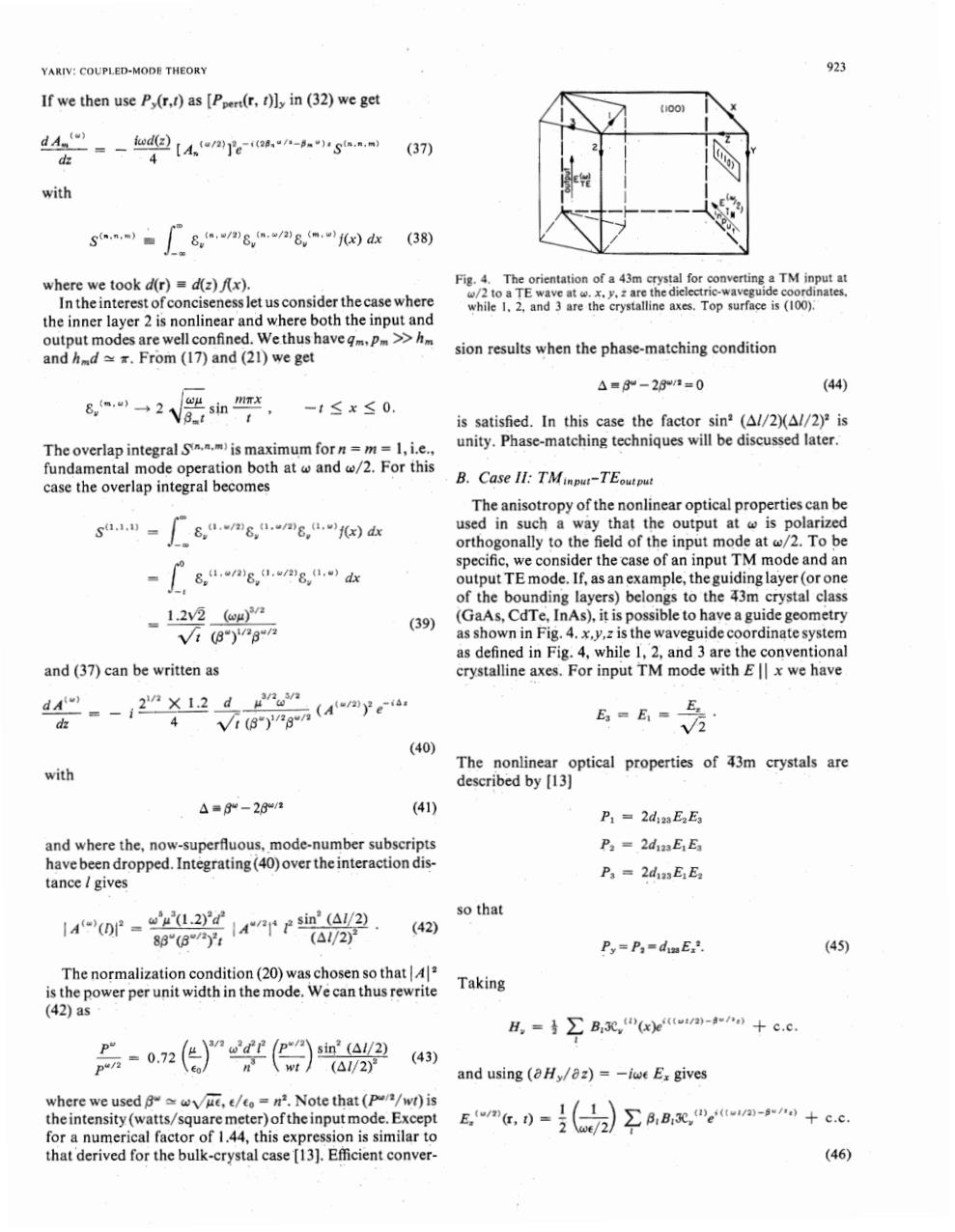正在加载图片...

YARIV:COUPLED-MODE THEORY 923 If we then use P,(r,t)as [Ppert(r,t)]y in (32)we get 【001 dA.( =-de【4um12ta.-."Sa dz 4 (37) with 8(8(fx)dx (38) where we took d(r)=d(z)fx). Fig.4.The orientation of a 43m crystal for converting a TM input at In the interest of conciseness let us consider the case where w/2 to a TE wave at w.x.y.z are the dielectric-waveguide coordinates. while 1.2.and 3 are the crystalline axes.Top surface is(100). the inner layer 2 is nonlinear and where both the input and output modes are well confined.We thus have gm,Pm>>hm and hmd.From (17)and (21)we get sion results when the phase-matching condition 4=8-28/=0 (44) 8nm.一2N8. μ sin mnx -t≤x≤0. is satisfied.In this case the factor sin2(Al/2)(Al/2)2 is The overlap integral Syn.n.m)is maximum for n =m=1,i.e., unity.Phase-matching techniques will be discussed later. fundamental mode operation both at w and /2.For this case the overlap integral becomes B.Case I1:TMinput-TEoutput The anisotropy of the nonlinear optical properties can be used in such a way that the output at w is polarized orthogonally to the field of the input mode at w/2.To be specific,we consider the case of an input TM mode and an 8,428,./28,1dk output TE mode.If,as an example,the guiding layer(or one of the bounding layers)belongs to the 43m crystal class =1.2v2u (39) (GaAs,CdTe,InAs),it is possible to have a guide geometry Vi(B)B2 as shown in Fig.4.x.y,z is the waveguide coordinate system as defined in Fig.4,while 1,2,and 3 are the conventional and (37)can be written as crystalline axes.For input TM mode with Ex we have =-2X12日2wn E=E1= E d 4 Vi(8g (4 √/2 (40) The nonlinear optical properties of 43m crystals are with described by [13] 4=8-28/2 (41) P1=2diasE2E3 and where the,now-superfluous,mode-number subscripts P2=2diEE3 have been dropped.Integrating(40)over theinteraction dis- P3=2disEEa tance gives 14o°=24r3 so that (41/2)9 (42) 83"(8y: Py=P:=dimE:. (45) The normalization condition(20)was chosen so thatA2 is the power per unit width in the mode.We can thus rewrite Taking (42)as H,=3∑Be,"”(xeua-w+c.c. sin"(Al/2) (△1/2) (43) and using (aHy/8z)=-iwe Ex gives where we used Bwvue,e/eo=n2.Note that (P/wt)is theintensity(watts/square meter)of the input mode.Except for a numerical factor of 1.44,this expression is similar to that derived for the bulk-crystal case [13].Efficient conver- (46)YARIV: COUPLED-MODE THEORY 923 If we then use Py(r,t) as [Ppert(r, t)Jy in (32) we get with where we took d(r) = d(z)Ax), In the interest of conciseness let us consider the case where the inner layer 2 is nonlinear and where both the input and output modes are well confined. We thus have qm,pm >> h, and h,d = T. From (17) and (21) we get 8- The overlap integral S(n,n,m) is maximum for n = m = 1, i.e., fundamental mode operation both at w and 0/2. For this case the overlap integral becomes (39) and where the, now-superfluous, .mode-number subscripts have been dropped. Integrating (40) over the interaction distance 1 gives The normalization condition (20) was chosen so that I A I is the power per unit width in the mode. We can thus rewrite (42) as where we used ,P adz, E/€,, = n2. Note that (P12/wt) is the intensity (watts/square meter) of the input mode. Except for a numerical factor of 1.44, this expression is similar to that'derived for the bulk-crystal case'[ 131. Efficient converFig. 4. The orientation of a 43m crystal for converting a TM input at w/2 to a TE wave at w. x, y, z are thedielectric-waveguide coordinates, while I, 2, and 3 are the crystalline axes. Top surface is (100): sion results when the phase-matching condition is satisfied. In this case the factor sin2 (Al/2)(A1/2l2 is unity. Phase-matching techniques will be discussed later. B. Case Ii: TMingut-TEoutput The anisotropy of the nonlinear optical properties can be used in such a way that the output at w is polarized orthogonally to the field of the input mode at w/2. To be specific, we co'nsider thecase of an input TM mode and an output TE mode. If, as an example, theguiding layer (or one of the bounding layers) belongs to the 43m crystal class (GaAs, CdTe, InAs), it is possible to have a guide geometry as shown in Fig. 4. x,y,z is the waveguide coordinate system as defined in Fig. 4, while 1,'2, and 3 are the conventional crystalline axes. For input TM mode with E I I x we have The nonlinear optical properties of a3m crystals are described by [13] so that Taking and using (8Hy/8z) = -iwt E, gives